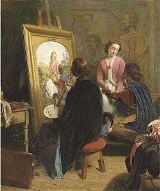
The Clique
Encyclopedia

Richard Dadd
Richard Dadd was an English painter of the Victorian era, noted for his depictions of fairies and other supernatural subjects, Orientalist scenes, and enigmatic genre scenes, rendered with obsessively minuscule detail...
in the late 1830s. Other members were Augustus Egg
Augustus Egg
Augustus Leopold Egg 2 May 1816 in London, England – 26 March 1863) was a Victorian artist best known for his modern triptych Past and Present , which depicts the breakup of a middle-class Victorian family.-Biography:...
, Alfred Elmore
Alfred Elmore
Alfred Elmore was a Victorian history and genre painter. He was born in Cork, Ireland, the son of Dr. John Richard Elmore, a surgeon who retired from the British Army to Clonakilty....
, William Powell Frith
William Powell Frith
William Powell Frith , was an English painter specialising in genre subjects and panoramic narrative works of life in the Victorian era. He was elected to the Royal Academy in 1852...
, Henry Nelson O'Neil
Henry Nelson O'Neil
Henry Nelson O'Neil was an historical genre painter and minor Victorian writer. He worked primarily with historical and literary subjects, but his best-known paintings dealt with the Indian Mutiny. Eastward, Ho!, dated August 1857 but exhibited the following year, depicts the British troops...
, John Phillip
John Phillip
John Phillip was a Victorian era painter best known for his portrayals of Spanish life. He was nicknamed "Spanish Phillip"....
and Edward Matthew Ward
Edward Matthew Ward
Edward Matthew Ward was an English Victorian narrative painter best known for his murals in the Palace of Westminster depicting episodes in British history from the English Civil War to the Glorious Revolution.-Early career:...
.
They have been described as “the first group of British artists to combine for greater strength and to announce that the great backward-looking tradition of the Academy was not relevant to the requirements of contemporary art”.
Foundation
Information about the activities of The Clique derives mainly from the reminiscences of Frith and a short essay published in the Art JournalArt Journal
Art Journal may refer to:* Art Journal , 1941–present, published by College Art Association of America* The Art Journal, 1839–1912, London* Art diary, art journal or visual journal, a daily journal kept by artists...
in 1898 by Gilbert Imray, a friend of the group. Both state that the group called themselves by this name at the time and that they formed a sketching club. Imray describes the aspirations of some members and explains that at their meetings they would all produce drawings on the same subject and ask non-artists such as Imray to judge the merits of the works.
They met together at the end of the 1830s and early 1840s. The group broke up in 1843 when Dadd became insane and was incarcerated after murdering his father. The others all became successful members of the Royal Academy of Arts (though O'Neil only became an associate member, not a full member). Their work was supported by the newly-founded Art Journal
Art Journal
Art Journal may refer to:* Art Journal , 1941–present, published by College Art Association of America* The Art Journal, 1839–1912, London* Art diary, art journal or visual journal, a daily journal kept by artists...
.
Ideas
The Clique was characterised by their rejection of academicAcademic art
Academic art is a style of painting and sculpture produced under the influence of European academies of art. Specifically, academic art is the art and artists influenced by the standards of the French Académie des Beaux-Arts, which practiced under the movements of Neoclassicism and Romanticism,...
high art in favour of genre painting, following the precedents of William Hogarth
William Hogarth
William Hogarth was an English painter, printmaker, pictorial satirist, social critic and editorial cartoonist who has been credited with pioneering western sequential art. His work ranged from realistic portraiture to comic strip-like series of pictures called "modern moral subjects"...
and David Wilkie
David Wilkie (artist)
Sir David Wilkie was a Scottish painter.- Early life :Wilkie was the son of the parish minister of Cults in Fife. He developed a love for art at an early age. In 1799, after he had attended school at Pitlessie, Kettle and Cupar, his father reluctantly agreed to his becoming a painter...
. This was in line with their view that art should be judged by the public, not by its conformity to academic ideals.
In the 1850s most members of The Clique became inveterate enemies of the Pre-Raphaelite Brotherhood
Pre-Raphaelite Brotherhood
The Pre-Raphaelite Brotherhood was a group of English painters, poets, and critics, founded in 1848 by William Holman Hunt, John Everett Millais and Dante Gabriel Rossetti...
, believing their art to be willfully eccentric and primitivist. Frith and O'Neil wrote many attacks on Pre-Raphaelite principles. However Egg became a friend and supporter of William Holman Hunt
William Holman Hunt
William Holman Hunt OM was an English painter, and one of the founders of the Pre-Raphaelite Brotherhood.-Biography:...
.
Portraits of members of The Clique were commissioned by Patrick Allan-Fraser for Hospitalfield House
Hospitalfield House
Hospitalfield House is an arts centre and historic house in Arbroath, Angus, Scotland regarded as "one of the finest country houses in Scotland". It is believed to be "Scotland's first school of fine art" and the first art college in Britain...
in Arbroath
Arbroath
Arbroath or Aberbrothock is a former royal burgh and the largest town in the council area of Angus in Scotland, and has a population of 22,785...
.
In the 1860s another group of artists with similar ideas became known as the St. John's Wood Clique.
Literature
- Cowling, Mary. Victorian Figurative Painting. London, Andreas Papadakis Publisher, 2001.
- Valentine, Helen, ed. Art in the Age of Queen Victoria: Treasures from the Royal Academy of Arts Permanent Collection. New Haven and London, Yale University Press/Royal Academy of Arts, London, 1999.

